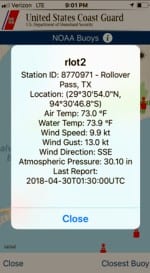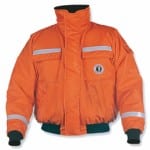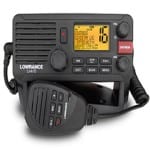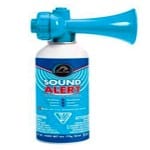 By Bob Currie, Vessel Examiner
By Bob Currie, Vessel Examiner
United States Coast Guard Auxiliary Flotilla 081-06-08
We have had our first cool spell on the peninsula. To many boaters that means putting the boat away until next spring, but to those of us that look at this as the beginning of the flounder season, we need to think about what changes we can expect when fishing this time of year. My neighbor and I ventured out last week on a very nice day. The water was flat, there was no wind, and it was quite pleasant. At least until the fog set in. One key to boating this time of year is to be prepared for any type of weather, and that includes rain, wind, and fog. There are several things you can do to operate safely in the winter.
Flotilla 081-06-08 is based at Coast Guard Station Galveston. The Coast Guard Auxiliary is the uniformed civilian component of the US Coast Guard and supports the Coast Guard in nearly all mission areas. The Auxiliary was created by Congress in 1939. For more information, please visit www.cgaux.org.
Obtain Weather Information
Listening to either a news media broadcast meteorologist or NOAA Weather Radio, coupled with local knowledge, should make everyone informed weather-wise.  Your VHF/FM marine radio has the ability to scan the weather channels. It is always best to include the weather channels when using your marine radio, but remember- it is not automatic. You must selectively scan the weather channels along with the marine channels. Most people by now know that I am a big fan of the Coast Guard app for smart phones. One source of weather information is the NOAA weather buoys. The Coast Guard App has an icon for locating your proximity to the various weather buoys. By clicking on a buoy, you can obtain the weather at that particular buoy. You can use this knowledge to predict changes in weather based on the reported wind direction, intensity, and your distance from that particular buoy.
Your VHF/FM marine radio has the ability to scan the weather channels. It is always best to include the weather channels when using your marine radio, but remember- it is not automatic. You must selectively scan the weather channels along with the marine channels. Most people by now know that I am a big fan of the Coast Guard app for smart phones. One source of weather information is the NOAA weather buoys. The Coast Guard App has an icon for locating your proximity to the various weather buoys. By clicking on a buoy, you can obtain the weather at that particular buoy. You can use this knowledge to predict changes in weather based on the reported wind direction, intensity, and your distance from that particular buoy.
File a Float Plan
As mentioned in another column, the best float plan I have ever seen can be found as part of the U.S. Coast Guard smart phone app. It not only asks specific questions needed to help rescuers find you, it will email the completed float plan to up to two contacts. Float plans completed using the Coast Guard app can be saved and used as many times as you wish, and can be edited to fit the current situation, including date and time, itinerary, and persons on board. Anyone on the boat can file a plan. You do not have to be the Skipper. Even Gilligan, the Howells, Ginger, the Professor and Mary Ann could have filed a float plan.
Dress for the Water Temperature
The best way to survive accidental immersion in cold water is to wear a life jacket. It will keep your head above water, keep you afloat, and provide a measure of thermal protection against hypothermia. The effects of cold water immersion are predictable and well documented by what is known as the 1-10-1 Principle:
– 1 minute: Upon immersion in cold water, the body reacts with an involuntary gasp, followed by hyperventilation of up to 10 times regular breathing (if the head is underwater during that initial deep gasp, a person can inhale enough water to drown). Avoid panicking; breathing will return to close to normal.
– 10 minutes: A person immersed in cold water will become incapacitated as limb muscles stop working and prevent swimming or self-rescue, so swimmers should attempt to rescue themselves before incapacitation becomes a factor. If this is not possible, try to get as much of the body out of the water as possible to delay the onset of hypothermia.
– 1 hour: After about 60 minutes (depending on the water temperature), the body continues to cool. The resulting hypothermia can create a range of symptoms from confusion to unconsciousness, eventually leading to death.
If you boat in cold weather, you may consider purchasing what is known as a float coat. It is a combination bomber-style jacket and Coast Guard Approved Type III life jacket. They keep you warm both above and in the water.
They make camouflage versions for duck hunters, but you really should get a high visibility version for open water use.
Have Some Form of Communication
I am a firm believer in having a marine FM/VHF radio on board at all times, but if you don’t have one,  at least have a cell phone with the Coast Guard app downloaded onto it. Things can go south so fast, and you need to keep your radio or phone within reach at all times. If you have a DSC-enabled marine radio, be sure to obtain an MMSI (Maritime Mobile Service Identity) and program it into your radio. The emergency distress button doesn’t work unless you do.
at least have a cell phone with the Coast Guard app downloaded onto it. Things can go south so fast, and you need to keep your radio or phone within reach at all times. If you have a DSC-enabled marine radio, be sure to obtain an MMSI (Maritime Mobile Service Identity) and program it into your radio. The emergency distress button doesn’t work unless you do.
Be Seen and Be Heard
Navigational lights are not just for running at night. They should be used also when visibility is restricted due to weather such as rain, dark clouds, and fog.  It is easy for bad weather to sneak up on you, and if that happens, turn on your navigation lights. If the fog sets in, listen for other boats running nearby, listen for fog horns, and sound your own noise making device frequently. This also means you should slow down when visibility is restricted. Be sure to test your noise making device before leaving the dock.
It is easy for bad weather to sneak up on you, and if that happens, turn on your navigation lights. If the fog sets in, listen for other boats running nearby, listen for fog horns, and sound your own noise making device frequently. This also means you should slow down when visibility is restricted. Be sure to test your noise making device before leaving the dock.
Summary
Safe boating is all about being prepared for the conditions you would expect to encounter. You just have to make a change in your equipment to adjust for the change in the season.
For more information on boating safety, please visit the Official Website of the U.S. Coast Guard’s Boating Safety Division at www.uscgboating.org. Questions about the US Coast Guard Auxiliary or our free Vessel Safety Check program may be directed to me at [email protected]. I am available to perform free Vessel Safety Checks, and I will come to your location to perform them. SAFE BOATING!
[11-12-2018]

 Posted in
Posted in 























